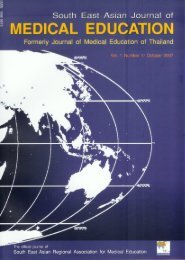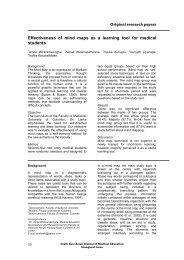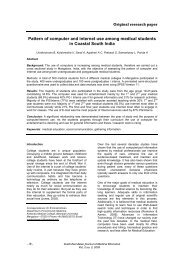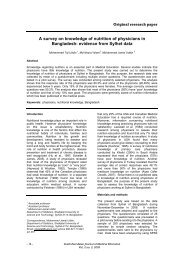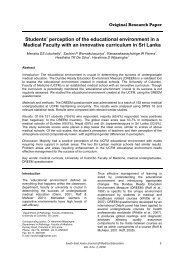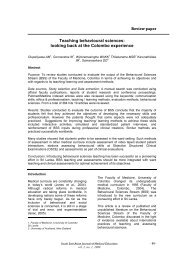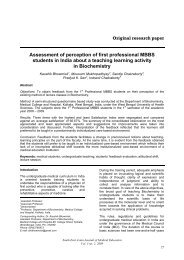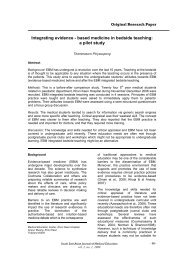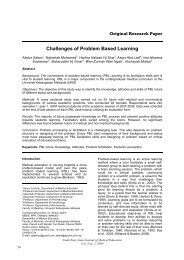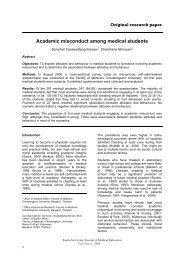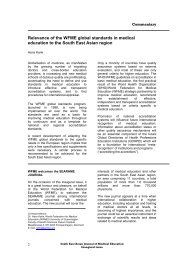Undergraduate Medical Curriculum of Universiti Sains Malaysia in ...
Undergraduate Medical Curriculum of Universiti Sains Malaysia in ...
Undergraduate Medical Curriculum of Universiti Sains Malaysia in ...
Create successful ePaper yourself
Turn your PDF publications into a flip-book with our unique Google optimized e-Paper software.
Figure 2: Spiral organization <strong>of</strong> the content <strong>of</strong> medical curriculum (Harden R.M, & Stamper N, 1999)<br />
Houseman Ship<br />
Q 4: How is the content organized<br />
The unique feature <strong>of</strong> the curriculum is the<br />
system based spiral arrangement <strong>of</strong> its content<br />
(Figure 2). A spiral curriculum has an iterative<br />
revisit<strong>in</strong>g <strong>of</strong> topics, subjects or themes<br />
throughout the course with deepen<strong>in</strong>g <strong>of</strong> the<br />
content, with each successive encounter<br />
build<strong>in</strong>g on the previous one (Harden &<br />
Stamper, 1999). All the three Phases <strong>of</strong> the<br />
curriculum are comb<strong>in</strong>ed <strong>in</strong> a spiral concept<br />
with a close relationship between one Phase<br />
to the other. Learn<strong>in</strong>g activities <strong>in</strong> Phase I<br />
forms the first level <strong>of</strong> the spiral, it is explored<br />
<strong>in</strong> depth <strong>in</strong> Phase II and Phase III. In the<br />
curriculum students move on through different<br />
experiences and there is a chance <strong>of</strong> revisit<strong>in</strong>g<br />
previous learn<strong>in</strong>g to re-explore and<br />
extent it, which is based on the constructivist<br />
learn<strong>in</strong>g approach. The content is <strong>in</strong>tegrated<br />
both horizontally and vertically while the spiral<br />
approach l<strong>in</strong>ked the theory to practice,<br />
<strong>in</strong>creas<strong>in</strong>g the time for cl<strong>in</strong>ical activities and<br />
allow<strong>in</strong>g students to spend more time with<br />
patients, so they can apply their theoretical<br />
knowledge <strong>in</strong>to cl<strong>in</strong>ical practice.<br />
Q 5: What educational strategies are<br />
adopted<br />
The school adopted a mix approach with<br />
emphasis on the SPICES strategy <strong>in</strong> its<br />
curriculum implementation. In Phase I there is<br />
a horizontal <strong>in</strong>tegration among the basic<br />
subjects with some amount <strong>of</strong> vertical<br />
<strong>in</strong>tegration <strong>in</strong> nurs<strong>in</strong>g and first aid block. In this<br />
Phase the <strong>in</strong>tegration is at the level <strong>of</strong><br />
harmonization and nest<strong>in</strong>g <strong>of</strong> the <strong>in</strong>tegration<br />
ladder. Phase II onwards the <strong>in</strong>tegration moves<br />
to a higher level like temporal coord<strong>in</strong>ation,<br />
shar<strong>in</strong>g, correlation and multidiscipl<strong>in</strong>ary<br />
especially, whereas <strong>in</strong> Phase III the <strong>in</strong>tegration<br />
to achieve the highest trans-discipl<strong>in</strong>ary and<br />
<strong>in</strong>ter/multidiscipl<strong>in</strong>ary level. (Harden, 2000).<br />
The community orientation started <strong>in</strong> Phase II<br />
through the CFCS block which cont<strong>in</strong>ued until<br />
year 5 as Family Medic<strong>in</strong>e and Community<br />
Medic<strong>in</strong>e Block. A number <strong>of</strong> areas for<br />
electives are <strong>of</strong>fered by the elective<br />
committee. Students are also allowed to<br />
choose their own area <strong>of</strong> <strong>in</strong>terest for elective<br />
study <strong>in</strong> year 4 elective post<strong>in</strong>g.<br />
The systemic approach is practiced <strong>in</strong> cl<strong>in</strong>ical<br />
teach<strong>in</strong>g where each student rotates based on<br />
their post<strong>in</strong>gs. In hospital they rotate <strong>in</strong><br />
outpatient and <strong>in</strong>patient, from general to<br />
specific health problems. They also rotate to<br />
other health care sectors, community cl<strong>in</strong>ics<br />
and so on and are monitored by log book or<br />
360 0 assessment. Though the curriculum is an<br />
<strong>in</strong>tegrated, problem-based and systemic, there<br />
are still some amount <strong>of</strong> teacher centered<br />
approach is practiced especially <strong>in</strong> year 1.<br />
This is because these students have<br />
<strong>in</strong>sufficient knowledge about their role <strong>in</strong><br />
student centre learn<strong>in</strong>g.<br />
South‐East Asian Journal <strong>of</strong> <strong>Medical</strong> Education<br />
Vol. 5 no. 2, 2011<br />
5




